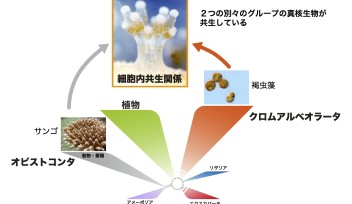mgu FY2014 Annual Report 3.3 fig2

Figure 2. Putative mechanism for the evolution of ARId (anhydrobiosis-related gene island) in the P. vanderplanki genome.
ARIds are genomic regions containing clusters of duplicated genes that are transcriptionally active during anhydrobiosis. (a) A gene of foreign origin (for example, LEA protein) is incorporated into P. vanderplanki genome by HGT and undergoes extensive duplications and shuffling. (b) A pre-existing P. vanderplanki gene originally not involved in anhydrobiosis and originating from another region of P. vanderplanki genome was inserted to a new locus by intragenomic duplication (IGD) and undergoes extensive duplications and shuffling to acquire or improve a specific function for desiccation tolerance. All the genes in the ARIds from both a,b become highly upregulated during anhydrobiosis (red arrows).
Copyright OIST (Okinawa Institute of Science and Technology Graduate University, 沖縄科学技術大学院大学). Creative Commons Attribution 4.0 International License (CC BY 4.0).














